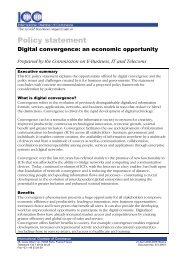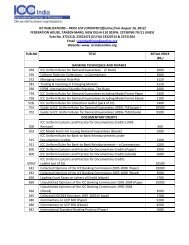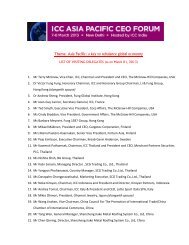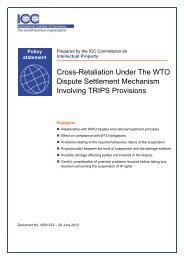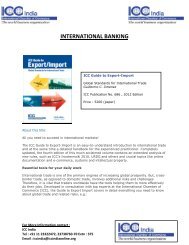2013 - ICC India
2013 - ICC India
2013 - ICC India
- No tags were found...
You also want an ePaper? Increase the reach of your titles
YUMPU automatically turns print PDFs into web optimized ePapers that Google loves.
<strong>ICC</strong> BANKING COMMISSION | <strong>2013</strong> GLOBAL RISKS TRADE FINANCE | APPENDIX C 6769 However, most of the importers using Trade Finance products will not be externally rated,so will be subject to a 100% risk weighting if a bank is using the Standardised approach.Because the Foundation IRB approach is risk-sensitive, if a Foundation IRB bank has arating for the importer, then whether they are at a competitive advantage or not (in terms ofcapital requirements) will depend upon the PD for the underlying importer.70 For exposures to banks, there are actually two different approaches available: in the firstapproach the RWA depends upon the sovereign rating of the country of the issuing bank;in the second approach, the RWA depends upon the issuing bank’s rating. It is up to aregulator as to which approach should be adopted by the confirming banks that it regulates.71 “No claim on an unrated bank may receive a risk weight lower than that applied to claimson its sovereign of incorporation”, §60, BCBS (2006). A similar rule applied for corporateexposures (§66 BCBS 206)72 BCBS (2011)73 Because firms are expected to adopt internal ratings across most rating classes at the sametime, most of the sovereigns may well be rated. Thus the issue of “flooring” RWAs at thelevel of an unrated sovereign which was an issue under the Standardized approach, andwhich was addressed in BCBS (2011) would likely not be as acute for IRB firms.74 In explaining this approach, the UK FSA has for example indicated (emphasis is that of theUK FSA) “More specifically, the IRB standards do not allow firms to anticipate reductions inexposures between the observation date and the default date, even if there is good reasonto believe these will take place. This is because not allowing reductions is considered to be asufficient proxy for the lack of a capital requirement on the new facilities assumed to comeonto a firm’s balance sheet over the run-off period of the existing ones.” (UK FSA (2007a)).75 BCBS (2011)76 Other trade finance products have not been altered and have CCFs ranging from 50% forperformance bonds to 100% for standby letters of credit77 “The types of instruments and the CCFs applied to them are the same as those inthe standardised approach, as outlined in paragraphs 82 to 89 with the exception ofcommitments, Note Issuance Facilities (NIFs) and Revolving Underwriting Facilities (RUFs).”§311, BCBS (2006). These facilities get a CCF of 75% for IRB RWA purposes.78 §83(i) of BCBS (2006). This is the rule for Standardised (and hence Foundation) CCFs, but§316 BCBS (2006) indicates that Advanced firms can only use their own estimates “providedthe exposure is not subject to a CCF of 100% in the foundation approach”. There are someother exposure types where a CCF of 100% is required but they are not considered relevantfor this paper, so are not mentioned.79 If an exposure is backed by real estate, which is not relevant in the case of most tradefinance transactions, then it is assigned to a different asset class with different RWA%.The list of eligible collateral under Basel II is broader than those recognised under Basel I(although Basel 2.5 and III left the list untouched).80 From a prudential perspective, it may be argued that if an importer does default on a tradefinance transaction, it presumably was unable to use the underlying collateral or sell it inorder to pay the issuing bank, meaning the collateral likely has low value (i.e. the very factthat the importer has defaulted may imply the collateral is not worth much). Given thatregulators are seeking to be prudent when setting capital requirements, if the collateral islikely to have low value in the event of the importer’s default then it may not be appropriateto recognise its mitigating effects.81 As with the Standardized approach, the range of recognised collateral is relatively narrowand would not cover many of the moveable goods which underpin international trade.82 We provide more detail on this below83 If a short-term external rating exists for a specific corporate or bank exposure, then adifferent set of risk weightings may be used (see BCBS (2006) §103-106 for example).However this will rarely be the case for short-term trade finance exposures.84 “Supervisors should ensure that claims with (contractual) original maturity under 3 monthswhich are expected to be rolled over (i.e. where the effective maturity is longer than 3months) do not qualify for this preferential treatment for capital adequacy purposes” §62BCBS (2006)85 The other exception is for repos that are entered with a 0.5 year maturity (§318 of BCBS(2006)).86 We do not show the calculation here, but is effectively the cash-flow-weighted average timeto receipt of cash-flows87 §322, BCBS (2006). The overriding concern of the regulators has been to ensure thattransactions where there is a relationship pressure to continue financing the counterpartyshould not be treated as being short-term in nature.88 BCBS (2011)



